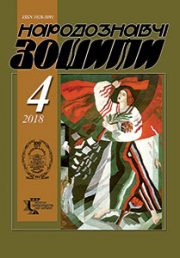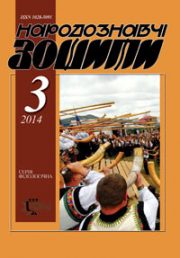The Ethnology Notebooks. 2018, 2 (140), 328—332.
UDK 7.012:745
DOI https://doi.org/10.15407/nz2018.02.328
Received 30.01.2018
«FOLK DESIGN»: THE DEFINITION THAT HAS NOT BECOME THE TERM
ORCID ID: https://orcid.org/0000-0002-4583-8195
Lebedieva Alona, Postgraduate student
Kiev National University of Culture and Arts
Str. of Yevhena Konoval’tsia, 36, Kyiv, 01601
Contacts: e-mail: goshalebedev@gmail.com
Abstrakt. The usage of widespread in our days notion is under investigation. It appeared for the first time in the Soviet professional Art’ magazines of the 1960-s, as a metaphor, having in mind not ornamented items of the folk art with predomination of practical function. Finally, this expression had changed its meaning in the mass media to the quite opposite — the modern stylization in the traditional manner.
Keywords: Decor, Design, Ethnical Trends in Fashion, Folk Art, Folk Design, Making, Stylization, Traditional Art
REFERENCES
Grabowski, J. (1977). Sztuka ludowa. Charakterystyki — porуwnania — odrкbnoњci. Warszawa: Wydawnictwa Artystyczne i Filmowe [in Polish].
Hornby, A. S. & Cowie. A. P. (1982). Oxford Advanced Learner’s Dictionary of Current English. Special Edition for the USSR. (Vol. 1). Moscow; Oxford [in English].
Lambert, M. & Marx L. (1946). English Popular and Traditional Art. London [in English].
Selivachov, M. (1995). Folk designs of Ukraine. — Doncaster: Bayda Books [in Enlish].
Bodrijjar, Zh. Sistema veshhej. Retrieved from: http://yanko.lib.ru/books/philosoph/baudrillard-le-systeme-des-objets-8l.pdf.
Materialy konferentsii «Making» (2012). Retrieved from: http://static.websys.no/files/sites/www.nordfo.no/ contentfiles/201209/all_papers_in_sessions.pdf.
Research on the design and development strategy of traditional folk culture industry.
Retrieved from: http://ieeexplore.ieee.org/document/ 5374925/?reload=true.
International Journal of the Construction History Society. Retrieved from: http://www.constructionhistory.co.uk/publications/construction-history-journal.
Tin M.B. Making and the sense it makes. Conceptual manifesto. Studies in Material Thinking, Vol. 9 (August 2013), ISSN 1177-6234, AUT University. Retrieved from: http://www.materialthinking.org, simultaneously published in Norwegian «Form Akademisk — Research Journal of Design and Design Education», Vol 6:2. Retrieved from: http://www.formakademisk.org/index.php/formakademisk/index.






